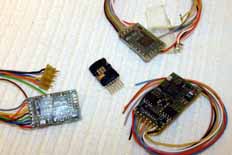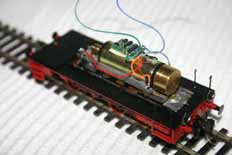Back to Contents
Back to DCC
Link to Sitemap
Zimo MX series

Zimo decoders are, by far, the most adaptable series of locomotive decoders we've come across. In fact we've managed to use them reliably and safely in a wide variety of models, both kit and ready to run; whether fitted with coreless, conventional or ringfield motors.
There doesn't seem much point in doing a blow-by-blow account as we did for the ESU LokPIlot v3.0, as you can see from many of the model locomotive entries on this site, we've used them widely and successfully. In fact I'd go as far as saying that if you're not sure, a Zimo decoder will drive your model as well as, or better than, any other decoder.
MX61 v2000
Although now obsolete, this decoder remains a firm favourite, so much so that we did a 'last time buy' from Great Little Trains (the importer at the time) when this decoder was cancelled. In light of its honourable mention it's included in our picture above, in the bottom right hand corner.
Its great strength is the ability to provide smooth and silent power for coreless motors. As such it has been used in Japanese brass models with Canon coreless motors and the odd bit of modern Trix with Maxon motors. It's also very good with conventional motors and I have used it with great success in modern European ready to run, such as my Liliput/Bachmann BR62. It does have a slight weakness though; at the very slowest speeds it suffers from a slight lack of drive, reducing torque. This means that the MX61 v2000 isn't really effective with old style Fleischmann or Märklin mechanisms and is best when paired with a high efficiency coreless motor in a well set-up chassis.
It's also a very safe decoder to use; you're not likely to damage a motor using this decoder on its default settings.
MX62


This is very useful decoder. It's suitable for driving a wide variety of locos and with a reasonable current rating of 0.6A they're the obvious decoder to use with Fleischmann locos as they're readily available with the NEM651 (6-pin) plug. The very adaptable drive means that you'll always get the best from the motor fitted to your model including the Fleischmann ringfield; though that particular example does require a fair amount of programming to get the best out of it.
The early versions of this decoder, as shown in the centre of the top photo, had a layer of black epoxy on one side and used the same CV settings as the MX61 v2000. Later versions use the more recent CV settings (as the MX63 and MX64) and also have live and ground pads exposed, so can be used with a home-built on-board power supply.
Despite the obvious comments about Fleischmann this decoder shouldn't be thought of as a one trick pony. The MX62 is available with a wide variety of connector/lead options and works well with a wide variety of motors; my Weinert DR BR103/V36 and Lima/scratchbuilt ÖBB 2067 are good examples of the decoder's ability to drive coreless motors smoothly, slowly and quietly. The V36 also shows the advantage of on-board power. Though I should mention that this feature is less obvious than the Lenz Power1 module that can be fitted to their Gold decoders.
Now discontinued, the MX62 has been superseded by the MX620.
MX620
In the interests of science (!!), I've purchased a couple of MX620s for evaluation. Although much of the CV set is identical to that of the MX62, it has an enhanced drive capability with specific tailoring for coreless motors. This was always going to be interesting and we've got a good few small locos with coreless motors so if there was a chance of a worthwhile upgrade it would be worth knowing about it!
So, how good is it? Well, in short, it's very good. Trial locos included the Faulhaber powered ÖBB 2067, a Trix ÖBB 2070 (with it's lovely, factory fitted Maxon) and a Brawa V100, where the MX620's small size and sensible power rating was going to be useful. The thoughts were that if the trials were successful then the V36 and maybe even Dave's Weinert BR81 might benefit...
There isn't any doubt in my mind that the coreless motor setting is very useful. Setting CV56 to a value of 100 activates the coreless motor drive. There is more fine tuning on this CV for both conventional (values 0-99) and coreless (value 100-199) motors. It's also recommended to set the frequency for 40kHz using CVs 9 and 112. In fact the whole of the routine for setting up the drive CVs seems easier than I remember with the MX62 - whatever the motor type in use.
And what does it do? Well if I said it made the drive quieter and smoother, almost fluid, when driving coreless motors would you be interested? Because that's exactly what it does. For this alone, I consider it a worthwhile upgrade over the MX62 when used with a coreless motor. With conventional motors the drive is as good as the MX62, so there doesn't even seem to be much of a trade-off. Highly recommended; I look forward to the upgraded CV set being available on the larger decoders, which is promised for software v25.
MX63 and MX64

It's worth dealing with these two together as, effectively, the MX64 is simply a larger, slightly cheaper, version of the MX63. In our picture at the top of this 'page the MX64 is in the lower right hand side, with the MX63 behind it. The CV set and capabilities of these two decoders are identical.
In practise, we've noted that the MX63 is subjectively better at driving coreless motors. Both are very good with modern Liliput/Bachmann locos with their cheap Chinese motors that can cause problems with many decoders. In fact, until the ESU LokPilotv3.0 came along, these were the only decoders I was prepared to use in these models.
Like the last MX62, these decoders can be used with home-built on-board power supplies. For certain models, such as the S B Modellbau remotored Märklin BR212, with a coreless motor and less than perfect pick up arrangements they're the only choice. Although the Lenz Gold and Power1 combination is useful, I'm not convinced about using them to drive coreless motors.
Further thoughts
All the Zimo decoders are capable and adaptable. I frequently use them to get good running from 'tricky' models; by that I mean those with either very good (coreless or modern can), or very poor (ringfield or Liliput/Bachmann) motors. Or those that may have lower or higher voltage specifications than the nominal 12-15v. Or those that have poor gear ratio selection. You get the picture...
However, to get the best running from such a wide variety of motors means that there are a good few CVs to adjust motor drive parameters. If you're not comfortable programming advanced CVs then these decoders are probably not for you.
There is a very good manual available (in English!) which helps the programming a great deal. The paragraphs on optimising the motor drive are well worth going through a couple of times to get the results absolutely cock-on. It's also worth making sure your model is well run-in before fitting the decoder. The drive CVs provide such fine tailoring that their effects can alter as the model mechanism beds in. My Weinert V36 was fitted with its decoder too early, it's now had to be re-programmed to keep it at the top of its game. And that was with just with the effect of being further run-in through normal use on a layout.
There is no doubt that this family of decoders is a firm favourite with us. They provided us with an early glimpse of what DCC could do and for many years led the rest of the DCC manufacturers in terms of the quality of the driving experience. Zimo decoders have continued to develop over the years and continue to grow performance and functionality. Though now they have some competition in the form of the Lenz Gold and ESU LokPilot v3.0. The prices accross the ranges are now very even, with all three manufacturer's products coming in at around £25, at the time of writing in January 2007.
Availability in the UK has also improved as the current models (MX620, MX63, MX64) are all available from a variety of sources, some contacts are available in our links page.
Conclusions
The positives
Highly adaptable drive that works very well on standard settings. Ability to connect on-board power modules. Compatibility with a wide variety of motor types. Good instruction manual.
The negatives
Wide compatibility means (necessarily) complex programming to get best perfomance - though the best is very good!



